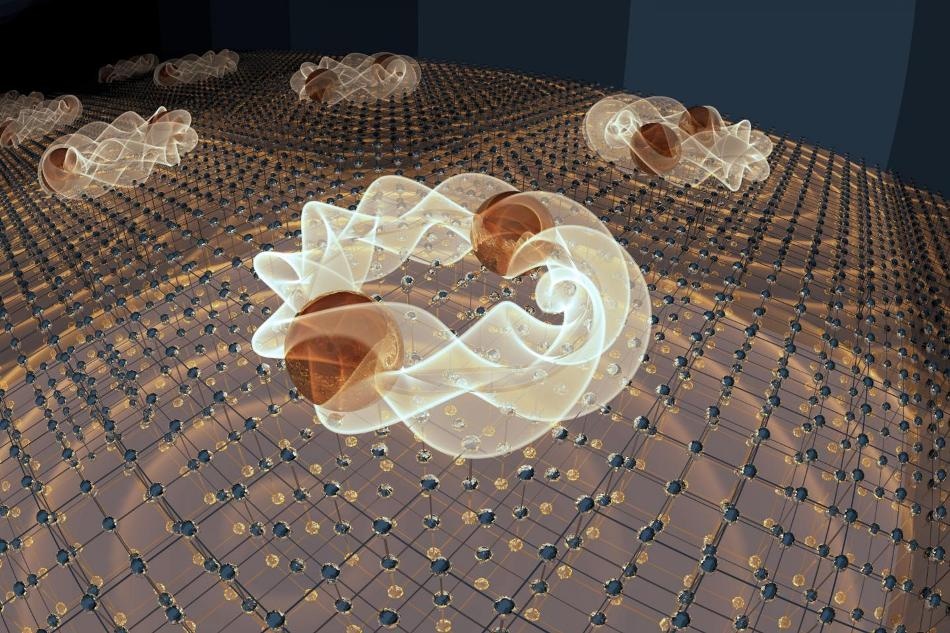Apr 9 2018
When an appliance is plugged in or a light switch flipped on, it looks as if electricity instantly flows through wires in the wall. However, in reality, tiny particles called electrons carry the electricity by gradually drifting through the wires. While progressing, the electrons sometimes encounter the atoms of the material and release some amount of energy with every collision.
 Artistic representation of high-spin pairs forming in a YPtBi crystal, leading to unconventional superconductivity. (Image credit: Emily Edwards, University of Maryland)
Artistic representation of high-spin pairs forming in a YPtBi crystal, leading to unconventional superconductivity. (Image credit: Emily Edwards, University of Maryland)
The extent to which the electrons move unobstructed is directly proportional to the electric conductivity of a material. In specific cases, changes in the environment dramatically improve the conductivity. For instance, when some materials are cooled to frigid temperatures, electrons combine together to flow unobstructed, without losing any energy—a phenomenon known as superconductivity.
At present, a research team from the University of Maryland (UMD) Department of Physics has worked together with collaborators and observed peculiar superconductivity that is dependent on highly abnormal electron interactions. Although this type of behavior has been estimated to take place in other non-material systems, it has stayed elusive to date.
The researchers’ study has been reported in the Science Advances journal on April 6, 2018, and reveals effects that are thoroughly different from the effects observed earlier in relation to superconductivity. The study was performed at UMD’s Center for Nanophysics and Advanced Materials, Condensed Matter Theory Center, and the Joint Quantum Institute, in partnership with Ames Laboratory at Iowa State University, the Lawrence Berkeley National Laboratory, the University of Otago, and the University of Wisconsin.
The interactions between electrons in superconductors are governed by a quantum property known as spin. In the case of a normal superconductor, electrons, with a spin of ½, pair up and flow unobstructed with the help of vibrations in the atomic structure. This theory is well-established and can characterize the properties of a majority of superconductors. In the new study, the researchers have unearthed evidence for a new kind of superconductivity in the material YPtBi, one that appears to be arising from spin-3/2 particles.
No one had really thought that this was possible in solid materials. High-spin states in individual atoms are possible but once you put the atoms together in a solid, these states usually break apart and you end up with spin one-half.
Johnpierre Paglione, Senior Author and UMD Physics Professor
The researchers were first astonished to find that YPtBi was a superconductor. Majority of the superconductors are initially reasonably good conductors and have several mobile electrons—an aspect that was missing in YPtBi. In terms of traditional theory, YPtBi would require around a thousand times more mobile electrons to become superconducting at temperatures less than 0.8 K. However, when the material is cooled to this temperature, the researchers observed that the superconductivity occurred anyhow. This was a first indication of something exotic taking place inside the material.
Once the researchers discovered the anomalous superconducting transition, they carried out measurements that enabled them to understand the basic electron pairing. They analyzed an effective property of superconductors, that is, their interaction with magnetic fields. As the material transitions to a superconductor, it tries to discharge any added magnetic field from its interior. However, the expulsion is not absolutely flawless. Near the surface, the magnetic field can still enter the material; however, it then rapidly decays away. The extent to which it enters is dependent on the nature of the electron pairing, and it changes as the material is cooled down more and more.
In order to investigate this effect, the team altered the temperature in a small sample of the material and exposed it to a magnetic field more than 10 times weaker than the magnetic field of Earth. Alterations in the magnetic properties of the superconductor is detected by a copper coil surrounding the sample, which enabled the researchers to sensitively measure even minute changes in the extent to which the magnetic field enters into the superconductor.
A strange magnetic intrusion was revealed by the measurement. When the material started to get warm from absolute zero, the field penetration depth for YPtBi increased linearly and not exponentially as it would in the case of a traditional superconductor. This effect, in combination with other theory calculations and measurements, restricted the possible ways for pairing up of the electrons. The team came to a conclusion that the best interpretation for the superconductivity was the disguising of electrons as particles with a higher spin—a possibility that was never before taken into consideration earlier in the framework of traditional superconductivity.
The finding out of this high-spin superconductor has provided a new direction for this research area. “We used to be confined to pairing with spin one-half particles,” stated Hyunsoo Kim, lead author of the study, who is a UMD assistant research scientist. “But if we start considering higher spin, then the landscape of this superconducting research expands and just gets more interesting.”
As of now, there still remain various open questions, such as how such pairing could take place in the first place. “When you have this high-spin pairing, what’s the glue that holds these pairs together?” queried Paglione. “There are some ideas of what might be happening, but fundamental questions remain—which makes it even more fascinating.”